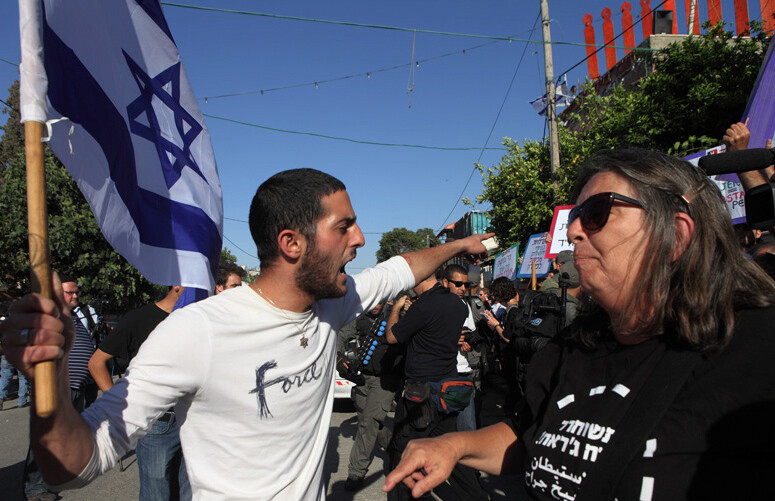The Electronic Intifada Jerusalem 3 June 2011

A settler confronts an Israeli activist during a protest against Jerusalem day in Sheikh Jarrah, occupied East Jerusalem, 1 June 2011.
ActiveStillsJERUSALEM (IPS) - As thousands of right-wing Israeli settlers descended on Jerusalem to celebrate the so-called unification of the city this week, Palestinian residents of occupied East Jerusalem were confronted by extreme provocations and the stark reality that their city remains very much divided.
“My shop was broken into a couple of times, a few times, when I’m here on Jerusalem Day,” explained East Jerusalem resident Basem Hallak, who has owned an antique shop in the heart of Jerusalem’s Old City for 25 years.
“You will see kids — by the meaning of kids [I mean] from the age of 16, 17 — and what they are doing is carrying machine guns, carrying guns, walking like, ‘This is our city and you [Palestinians] are out of the game. You are out, completely out,’” Hallak told IPS.
Jerusalem Day is an annual event that commemorates the “reunification” of Jerusalem in 1967, when Israeli forces captured East Jerusalem from Jordanian control during the June War.
The international community doesn’t recognize the Israeli government’s claims to East Jerusalem. Still, Israel has maintained the position that Jerusalem cannot be divided in the advent of a peace agreement with the Palestinian leadership, which aims to make East Jerusalem the capital of a future Palestinian state.
Provocative march
On Wednesday, 1 June, thousands of right-wing Israelis, including a large number of Israeli settlers from the occupied West Bank, participated in the annual Flag March through East Jerusalem for Jerusalem Day.
Waving Israeli flags, dancing and singing, participants marched from the hotbed Palestinian neighborhood of Sheikh Jarrah, an area in which extremist Israeli settlers have taken over Palestinian homes and continue to threaten residents — through the Muslim Quarter of the Old City on their way to the Wailing Wall. It was reported that approximately 3,000 Israeli police officers, including border police and undercover units, were on patrol to secure the march.
The municipality of Jerusalem contributed 100,000 shekels (approximately $30,000) to pay for the event, which Palestinian Jerusalemites — who number approximately 300,000 residents — viewed as an extreme act of provocation.
“I remember from the first time they started with a very small number [of marchers] and then every year it started getting bigger and bigger. They started blocking all the streets, all the roads, isolating the city of Jerusalem, making the city of Jerusalem under the Israeli authority just for the settlers, for the really fanatic Israelis,” Hallak, who lives on the Mount of Olives in East Jerusalem, told IPS.
“This is all under the protection of the soldiers and the police; [the marchers] can do whatever they want. They can burn shops, they can burn cars and this is what they have been doing for the last good number of years.”
He explained that every year, Israeli police and soldiers pressure him to close his shop early on Jerusalem Day, but that his decision to remain open is a form of resistance. “It’s resisting because they want to clear us from the city, like we don’t exist anymore in the city,” Hallak said.
The Israeli government passed a law in July 1980 which states that “Jerusalem, complete and united, is the capital of Israel.” More recently, in a speech before the US Congress on 24 May, Israeli Prime Minister Benjamin Netanyahu reaffirmed the Israeli government’s claims to all of Jerusalem, stating that “Jerusalem must never again be divided. Jerusalem must remain the united capital of Israel.”
Netanyahu also held a special cabinet meeting on Sunday, 29 May, at the Tower of David museum inside Jerusalem’s Old City. There, he unveiled a multi-year, $100-million investment package for the city and said “The unity of the city is one of the fundamentals of the unity of the nation of Israel.”
Jerusalem day “an immediate threat”
According to Sergio Yahni, co-director of the Alternative Information Center, a progressive joint Palestinian-Israeli activist organization, provocative Jerusalem Day events are meant to intimidate Palestinian residents of Jerusalem and reflect the policies of the current extremist Israeli government.
“Jerusalem Day became a nationalistic orgy and provocation on the Palestinian population of the city. More than anything else, it reflects current policies, national and municipal policies, towards the Palestinian population,” Yahni told IPS.
“Jerusalem Day became an immediate threat to the Palestinian population of East Jerusalem. It is a violent threat. It is an immediate threat of ethnic cleansing and expulsion. We see thousands of settlers dancing, jumping in the streets in a violent way that makes Palestinians in Jerusalem feel unwanted,” he said.
Ali Jiddah, a longtime Palestinian political activist and alternative tour guide based in Jerusalem’s Old City, told IPS that he refers to Jerusalem Day as “Arrogance Day.”
“I call it the day of [arrogance] because Israelis, on that day, [their] behavior, you will find what’s the meaning of [arrogance]. You feel that in some way Israelis are totally drunk by what they have achieved concerning the Old City,” Jiddah said. “They will come down in groups in the streets, [provoking] Palestinians, trying to attack Palestinians.”
While Jiddah said that Jerusalem Day is miserable for the city’s Palestinian residents, he explained that Israeli provocations motivate Palestinians to keep fighting to end the occupation and regain their rights.
“What’s good about it is [that] the provocation [the Palestinians] feel from the Israeli side makes them more determined to stand firm, to go on to be strong and to be determined to go on with their fight against the occupation,” Jiddah said.
“So a day will come [when Jerusalem Day] will be a joyful day. It will be a day of happiness. It will be a day of ceremonies for Palestinians [because] they got rid of the occupation.”
All rights reserved, IPS - Inter Press Service (2011). Total or partial publication, retransmission or sale forbidden.



